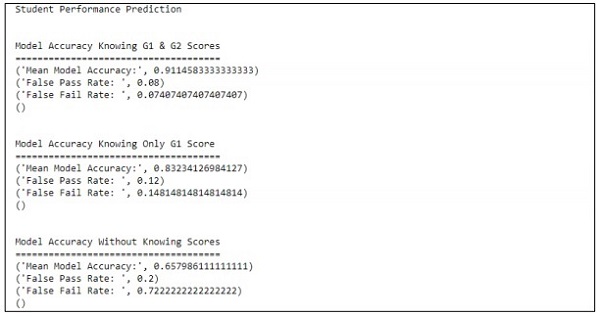Cải thiện hiệu suất dự đoán
Trong chương này, chúng tôi sẽ tập trung vào việc xây dựng một mô hình giúp dự đoán kết quả hoạt động của học sinh với một số thuộc tính có trong đó. Trọng tâm là hiển thị kết quả không đạt của học sinh trong một kỳ thi.
Quá trình
Giá trị mục tiêu của đánh giá là G3. Các giá trị này có thể được phân loại và phân loại thêm là thất bại và thành công. Nếu giá trị G3 lớn hơn hoặc bằng 10 thì học sinh đó đạt yêu cầu.
Thí dụ
Hãy xem xét ví dụ sau, trong đó mã được thực thi để dự đoán hiệu suất nếu học sinh -
import pandas as pd
""" Read data file as DataFrame """
df = pd.read_csv("student-mat.csv", sep=";")
""" Import ML helpers """
from sklearn.preprocessing import LabelEncoder
from sklearn.model_selection import train_test_split
from sklearn.metrics import confusion_matrix
from sklearn.model_selection import GridSearchCV, cross_val_score
from sklearn.pipeline import Pipeline
from sklearn.feature_selection import SelectKBest, chi2
from sklearn.svm import LinearSVC # Support Vector Machine Classifier model
""" Split Data into Training and Testing Sets """
def split_data(X, Y):
return train_test_split(X, Y, test_size=0.2, random_state=17)
""" Confusion Matrix """
def confuse(y_true, y_pred):
cm = confusion_matrix(y_true=y_true, y_pred=y_pred)
# print("\nConfusion Matrix: \n", cm)
fpr(cm)
ffr(cm)
""" False Pass Rate """
def fpr(confusion_matrix):
fp = confusion_matrix[0][1]
tf = confusion_matrix[0][0]
rate = float(fp) / (fp + tf)
print("False Pass Rate: ", rate)
""" False Fail Rate """
def ffr(confusion_matrix):
ff = confusion_matrix[1][0]
tp = confusion_matrix[1][1]
rate = float(ff) / (ff + tp)
print("False Fail Rate: ", rate)
return rate
""" Train Model and Print Score """
def train_and_score(X, y):
X_train, X_test, y_train, y_test = split_data(X, y)
clf = Pipeline([
('reduce_dim', SelectKBest(chi2, k=2)),
('train', LinearSVC(C=100))
])
scores = cross_val_score(clf, X_train, y_train, cv=5, n_jobs=2)
print("Mean Model Accuracy:", np.array(scores).mean())
clf.fit(X_train, y_train)
confuse(y_test, clf.predict(X_test))
print()
""" Main Program """
def main():
print("\nStudent Performance Prediction")
# For each feature, encode to categorical values
class_le = LabelEncoder()
for column in df[["school", "sex", "address", "famsize", "Pstatus", "Mjob",
"Fjob", "reason", "guardian", "schoolsup", "famsup", "paid", "activities",
"nursery", "higher", "internet", "romantic"]].columns:
df[column] = class_le.fit_transform(df[column].values)
# Encode G1, G2, G3 as pass or fail binary values
for i, row in df.iterrows():
if row["G1"] >= 10:
df["G1"][i] = 1
else:
df["G1"][i] = 0
if row["G2"] >= 10:
df["G2"][i] = 1
else:
df["G2"][i] = 0
if row["G3"] >= 10:
df["G3"][i] = 1
else:
df["G3"][i] = 0
# Target values are G3
y = df.pop("G3")
# Feature set is remaining features
X = df
print("\n\nModel Accuracy Knowing G1 & G2 Scores")
print("=====================================")
train_and_score(X, y)
# Remove grade report 2
X.drop(["G2"], axis = 1, inplace=True)
print("\n\nModel Accuracy Knowing Only G1 Score")
print("=====================================")
train_and_score(X, y)
# Remove grade report 1
X.drop(["G1"], axis=1, inplace=True)
print("\n\nModel Accuracy Without Knowing Scores")
print("=====================================")
train_and_score(X, y)
main()Đầu ra
Đoạn mã trên tạo ra kết quả như hình dưới đây
Dự đoán chỉ được coi là tham chiếu đến một biến. Với tham chiếu đến một biến, dự đoán kết quả học tập của học sinh như được hiển thị bên dưới:
